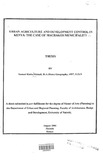| dc.description.abstract | Urban agriculture, described as any agricultural activity within the boundaries of an
urban center encompassing all kinds of crop cultivation and animal husbandry is not a
new phenomena rather it is as old as urbanization itself. Food production was an
important phenomenon of both pre-industrial and industrial cities. During the last two
decades, these activities have been on the increase in most developing countries and
Africa in particular.
However,in most African counties, Kenya included, urban agriculture is considered
illegal. Local authority By-laws usually dating from the colonial times simply forbid any
agricultural activity within the boundaries of urban centers. A large number of urban
dwellers continue to practice urban agriculture, contrary to the By-laws, while urban
managers and planners quietly ignore the practice.
This study aimed at examining the relation between urban agriculture and development
control with a case study of Machakos Municipality.
The research methodology employed included the use of primary and secondary data. In
the collection of data from the primary sources, structured questionnaires and scheduled
interviews for 100 households (70 Farming and 30 Non farming) and 30 market traders
dealing with agricultural produce were used. Secondary data was collected from among
others, Machakos District Physical Planning Office, Agriculture Office, Machakos
Municipal Council Offices. Other tools applied included informal discussions, personal
observation, and photography The data collected was analyzed using the Statistical
Package for Social Sciences (SPSS) after which outputs generated were used as input in
Microsoft excel to generate graphs and charts. Analyzed data was then presented using
frequency tables. pie charts and bar graphs
The study found out that, the practice of urban agriculture in Machakos municipality is
prohibited by the Public Health Act cap 242. the Local Government Act cap 265 and
General nuisance by-laws, 1999 amendments. The Physical Planning Act of 1996 does
not recognize the activity as one of the urban land uses and subjects every land including
private land to planning. Furthermore, these legislations appear to conflict with other land
related Acts such as the Registration of Titles Act Cap 281 which give conditional
powers to the owner of land, and the Registered Land Act Cap 300
Despite the existence of such legislations that should guide planning and growth of the
town, 98 percent of the households interviewed were not aware of their existence.
It was established that, the practice is not confined to individual households as both
government; religious and educational institutions are involved. Several factors were
found to encourage the practice among them large family sizes, lengthy period of urban
residence, and availability of open space.
The activity was found to play a significant role in the municipality's economy. It
provides domestic food supply (74 percent of the households interviewed produced crops
for subsistence purpose) Besides, it conserves soil, utilizes urban waste and has greening
effect among others. In terms of development control with regard to agriculture, It was
found out that the municipal council does not sensitize the residents on the existence of
planning legislations and majority are not aware, there is lack of enforcement of the
same, apparent conflicts in the existing legislations governing ownership and use of land,
Lack of zoning By-laws and an approved Local Physical Development Plan to guide
development and provision of infrastructure. It was also found that UA has significant
influence on the towns shape and rate of growth.
The study concludes that urban agriculture is practiced out of a 'felt need. Although
gazettment of the peri urban areas render it illegal, people continue to practice it. Local
authorities rarely develop infrastructure in the peri-urban areas due to lack of a Local
Physical Development Plan that could influence the residents to change the use of land.
The incorporation of the peri-urban areas into the urban areas does not revoke the special
conditions for use of land formally in the- rural areas. The Registration of Titles Act cap
281 allow agriculture in the formally rural areas while the PPA of 1996 and the General
Nuisance By-laws prohibit the activity in the newly incorporated land.
It is on this basis that the study recommends that municipal boundaries should not be
extended arbitrary by the Minister for Local government. The local authority should
before hand prepare a local physical development plan and zoning schemes for the periurban
area to determine the minimum acceptable land sizes and form the basis for
provision of infrastructure. Integration of agriculture to the urban system arises from its
potential in future to feed the municipality and includes sensitization of the local
community on the dangers of using raw sewer and industrial effiuent to produce crops,
the need to conserve the environmentally fragile areas and employment of an agricultural
officer by the local authority to manage farming. There is need for civic education to
sensitize the residents on the existence and importance of planning law and by-laws.
The laws that govern the use and planning of land should be harmonized to facilitate the
integration of agriculture to the urban system. UA if properly promoted has potential to
contribute significantly to the Government's policy of proper urban development. | en |

